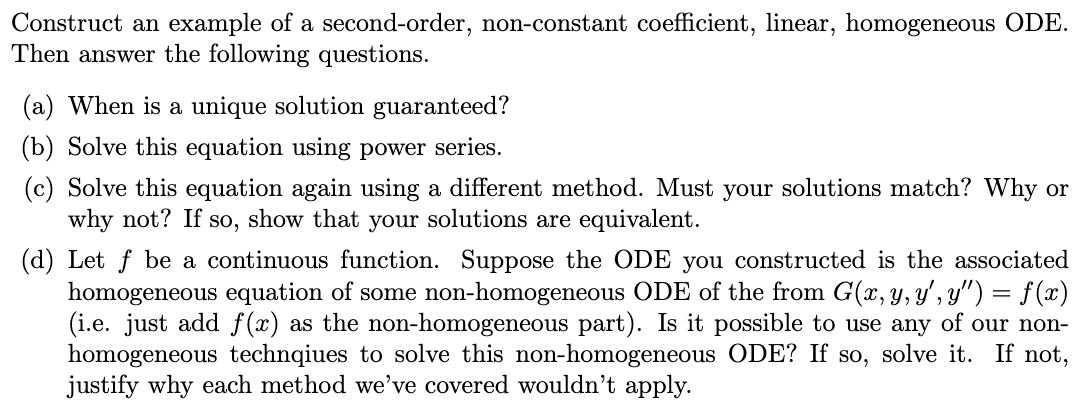Construct an example of a second-order, non-constant coefficient, linear, homogeneous ODE. "hen answer the following questions. (a) When is a unique solution guaranteed? b) Solve this equation using power series. (c) Solve this equation again using a different method. Must your solutions match? Why or why not? If so, show that your solutions are equivalent. (d) Let f be a continuous function. Suppose the ODE you constructed is the associated homogeneous equation of some non-homogeneous ODE of the from G(x, y, y', y") = f(x) (i.e. just add f(x) as the non-homogeneous part). Is it possible to use any of our non- homogeneous technqiues to solve this non-homogeneous ODE? If so, solve it. If not, justify why each method we’ve covered wouldn't apply.
Construct an example of a second-order, non-constant coefficient, linear, homogeneous ODE. "hen answer the following questions. (a) When is a unique solution guaranteed? b) Solve this equation using power series. (c) Solve this equation again using a different method. Must your solutions match? Why or why not? If so, show that your solutions are equivalent. (d) Let f be a continuous function. Suppose the ODE you constructed is the associated homogeneous equation of some non-homogeneous ODE of the from G(x, y, y', y") = f(x) (i.e. just add f(x) as the non-homogeneous part). Is it possible to use any of our non- homogeneous technqiues to solve this non-homogeneous ODE? If so, solve it. If not, justify why each method we’ve covered wouldn't apply.
Algebra & Trigonometry with Analytic Geometry
13th Edition
ISBN:9781133382119
Author:Swokowski
Publisher:Swokowski
Chapter5: Inverse, Exponential, And Logarithmic Functions
Section5.6: Exponential And Logarithmic Equations
Problem 64E
Related questions
Question

Transcribed Image Text:Construct an example of a second-order, non-constant coefficient, linear, homogeneous ODE.
Then answer the following questions.
(a) When is a unique solution guaranteed?
(b) Solve this equation using power series.
(c) Solve this equation again using a different method. Must your solutions match? Why or
why not? If so, show that your solutions are equivalent.
(d) Let f be a continuous function. Suppose the ODE you constructed is the associated
homogeneous equation of some non-homogeneous ODE of the from G(x, y, y', y") = f(x)
(i.e. just add f(x) as the non-homogeneous part). Is it possible to use any of our non-
homogeneous technqiues to solve this non-homogeneous ODE? If so, solve it. If not,
justify why each method we've covered wouldn't apply.
Expert Solution
This question has been solved!
Explore an expertly crafted, step-by-step solution for a thorough understanding of key concepts.
Step by step
Solved in 3 steps with 3 images

Recommended textbooks for you

Algebra & Trigonometry with Analytic Geometry
Algebra
ISBN:
9781133382119
Author:
Swokowski
Publisher:
Cengage

Algebra & Trigonometry with Analytic Geometry
Algebra
ISBN:
9781133382119
Author:
Swokowski
Publisher:
Cengage